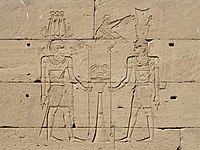Mandulis
| Mandulis in hieroglyphics | ||||||
|---|---|---|---|---|---|---|
| mostly |
Merwel Mrwl |
|||||
| Two forms of manduli facing each other ( Kalabsha temple) | ||||||
Mandulis , also Merwel or Menerwel , is a sun deity from Lower Nubia .
mythology
Mandulis had a special connection with Isis , who owned one of her temples in Philae . The Greek historian Strabo already wrote: "In addition to Isis, a large, colorful falcon was worshiped in Philae as an image of the soul of Horus and Re , which is said to have flown in from Ethiopia ." This is certainly mandulis.
presentation

Mandulis is depicted as a falcon like the god Horus or in human form with a crown, combined with ostrich feathers, ram's horns, a sun disk and urea . Another form of representation is similar to the Ba, a bird with a human head. However, in this form he wears the characteristic feather crown.
Cult places
His main place of worship was the Kalabsha temple, where he was also depicted as a young god with a youthful lock .
Pharaoh Ptolemaios VIII. Euergetes II. And his two queens Cleopatra "the sister" and Cleopatra "the wife" expanded the Kalabsha temple for the local "lord of heaven, sun god and son of Zeus ( Horus )", Mandulis. During the annual cult trip of Isis of Philae through Nubia , she regularly visited the Temple of Mandulis.
Although the Roman emperor Augustus never visited this temple, he had it rebuilt and most of the reliefs added . Many of them show him making offerings for Mandulis, Isis and other gods.
See also
literature
- Hans Bonnet : Lexicon of the Egyptian religious history. 3rd unchanged edition, Nikol-Verlag, Hamburg 2000, ISBN 3-937872-08-6 , pp. 439-440.
- Richard H. Wilkinson : The world of the gods in ancient Egypt. Faith - Power - Mythology. Theiss, Stuttgart 2003, ISBN 3-8062-1819-6 , pp. 114-115.
